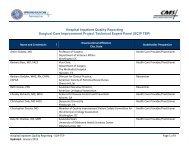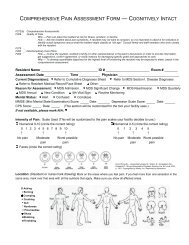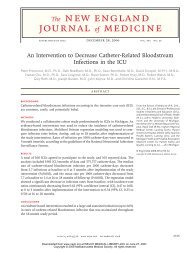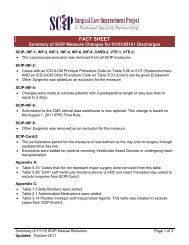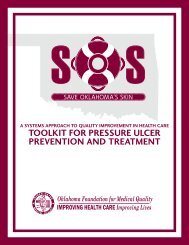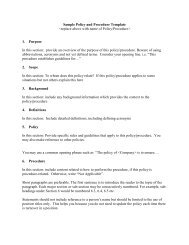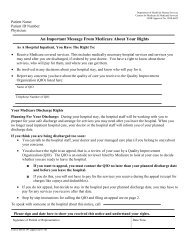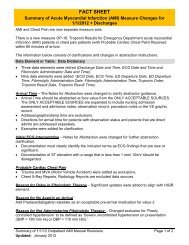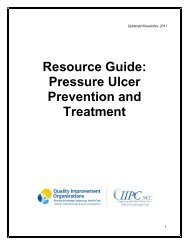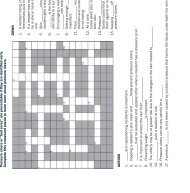Pressure Ulcer Brochure - Oklahoma Foundation for Medical Quality
Pressure Ulcer Brochure - Oklahoma Foundation for Medical Quality
Pressure Ulcer Brochure - Oklahoma Foundation for Medical Quality
You also want an ePaper? Increase the reach of your titles
YUMPU automatically turns print PDFs into web optimized ePapers that Google loves.
“Doctor, Please Talk To Me.”<br />
Communicate with patients, family members and nursing staff about appropriate prevention and treatment techniques. Use the expertise<br />
of specialists/nurses certified in wound care and consider a referral to a wound center.<br />
When The Threat Of Litigation Arises:<br />
Take steps to reestablish trust with the family, reassess the patient, reevaluate the care plan, document problem behaviors, and incorporate<br />
<strong>Quality</strong> Improvement principles 7 . If you use and document accepted standards of care <strong>for</strong> prevention and treatment and communicate<br />
with the patient and family, you are less likely to be at risk <strong>for</strong> litigation.<br />
“Doctor, Please Notice Me”<br />
1<br />
Russo, CA, Steiner C, Spector W. Hospitalizations related to pressure ulcers 2006. HCUP Statistical Brief #64, December 2008. Agency <strong>for</strong> Healthcare<br />
Research <strong>Quality</strong><br />
2<br />
Armstrong DG, Ayello EA, Capitulo KL, et al. New opportunities to improve pressure ulcer prevention and treatment: implications of the CMS inpatient<br />
hospital care present on admission (POA) indicators/hospital-acquired conditions (HAC) Policy. J Wound Ostomy Continence Nursing. 2008;35(5):485-<br />
492.<br />
3<br />
Centers <strong>for</strong> Medicare & Medicaid Services, Medicare Program; Proposed Changes to the Hospital Inpatient Prospective Payment System and Fiscal Year<br />
2009 Rates; Proposed Changes to Disclosure of Physician Ownership in Hospitals and Physician Self- Referral Rules; Proposed Collection of In<strong>for</strong>mation<br />
Regarding Financial Relationships Between Hospitals and Physicians; Proposed Rule Federal Register. 2008;73(84):23550.<br />
4<br />
Hanging Wet-to-Dry Dressings Out to Dry, Liza G. Ovington, PhD, CWS; Home Healthcare Nurse, p 477, vol 19 no 8 August 2001; ©2001 Lippincott<br />
Williams & Wilkins, Inc<br />
5<br />
Bryant, 2007<br />
6<br />
AHCPR, 1994; WOCN Society 2001<br />
7<br />
Risk management <strong>for</strong> pressure ulcers: when the family shows up with a camera. Levine JM, Savino F, Peterson M Wolf CR; Journal of the American<br />
<strong>Medical</strong> Directors Association. 9(5):360-3, 2008 Jun.<br />
Your Patient’s Largest Organ Needs Your Attention.<br />
Insights For Reducing Costs, Pain And Suffering And Physician Risk.<br />
This material was prepared by <strong>Oklahoma</strong> <strong>Foundation</strong> <strong>for</strong> <strong>Medical</strong> <strong>Quality</strong>, the Medicare <strong>Quality</strong> Improvement Organization <strong>for</strong> <strong>Oklahoma</strong>, under contract with the Centers<br />
<strong>for</strong> Medicare & Medicaid Services (CMS), an agency of the U.S. Department of Health and Human Services. The contents presented do not necessarily reflect CMS policy.<br />
962PU-1034-OK-510
Physicians, Reduce Your Risk And Improve Care<br />
2.5 million patients are treated <strong>for</strong> pressure ulcers every<br />
With these <strong>for</strong>midable costs, pain and suffering, and potential<br />
year 1 . The national cost of care exceeds $11 billion each<br />
<strong>for</strong> litigation, it’s time to give the skin the attention it<br />
year 2 , with an average DRG payment of $43,180 per patient deserves, and reduce your risk. This guide presents the latest<br />
<strong>for</strong> treatment. 3 Serious pressure ulcers are considered a “never science and recommendations <strong>for</strong> incorporating principles of<br />
event” among hospital-acquired conditions with payment<br />
pressure ulcer prevention into everyday practice and<br />
implications.<br />
using appropriate treatment methodology. For more detailed<br />
in<strong>for</strong>mation, visit http://www.ofmq.com/sos-tools.<br />
“Doctor, Please Look At Me”<br />
Skin assessment <strong>for</strong> high-risk individuals should be part of<br />
your routine practice. It doesn’t take an expensive CAT Scan,<br />
MRI, endoscopy or even a lab test! Almost 90% of pressure<br />
ulcers occur in the posterior pelvic region and the heel/ankle<br />
region. It is particularly essential to assess these pressure points<br />
on elderly and immobile patients. It takes 2-3 minutes to assess<br />
as preventable and primarily reversible affliction.<br />
<strong>Pressure</strong> ulcers that<br />
reach full thickness<br />
damage (stages 3&4) will<br />
never heal beyond 80%<br />
tensile strength. Assess<br />
the skin early and often<br />
to prevent worsening of<br />
pressure ulcers.<br />
The Best Treatment Is Prevention<br />
Who Is At Risk<br />
High Risk Factors <strong>for</strong> <strong>Pressure</strong> <strong>Ulcer</strong> Patients<br />
• Elderly<br />
• Immobile<br />
• Neurologically Impaired<br />
• Prolonged OR Time<br />
• Time in ER<br />
• Complicated Hospital Course<br />
• Co-morbidities (diabetes, vascular diseases, renal compromise)<br />
• Chronically Ill<br />
• Obese/Malnourished<br />
• Post-Surgical<br />
• Incontinent<br />
• Chronic Pain<br />
Where To Look<br />
Key Areas Susceptible To <strong>Pressure</strong> <strong>Ulcer</strong>s<br />
• Bony Prominences<br />
• Posterior Pelvic Region<br />
• Heels and Ankles<br />
What To Look For<br />
Conditions That Will Alter Your Plan Of Care<br />
• Be familiar with latest staging guidelines<br />
(http://www.npuap.com)<br />
• Notice reddened areas.<br />
• Learn to differentiate pressure ulcers from other types of<br />
wounds.<br />
• Wounds such as diabetic and neuropathic ulcers and<br />
venous arterial insufficiency ulcers are often incorrectly<br />
classified as pressure ulcers. Misidentifying wound etiology<br />
can lead to an incorrect treatment plan.<br />
• For example: Treating an exudating venous ulcer as a<br />
pressure ulcer will be fruitless. Applying full compression<br />
on a leg without establishing arterial status, such as<br />
with an ankle-brachial index (ABI) or toe-brachial index<br />
(TBI) is negligent.<br />
Opportunities For Assessment<br />
• On admission into acute care - Pre<strong>for</strong>m a head to toe,<br />
front to back assessment. Physician should document<br />
breakdown on admission (consistent with nurse documentation).<br />
• In office - Check sacral area when doing exams such as<br />
rectal and hemocult testing. Assess pressure points on<br />
elderly and immobile patients.<br />
• Be<strong>for</strong>e dictating discharge summary from acute care<br />
- Check <strong>for</strong> skin breakdown. Make arrangements <strong>for</strong><br />
wound care if needed.<br />
• Post surgery - as patient is moved to gurney<br />
“Doctor, Dress Me Up And Treat Me Right”<br />
Gauze For Alarm<br />
Bacteria can pass through 64 layers of gauze. The infection rate with gauze dressings is nearly 3x higher than with moisture retentive<br />
dressings 4 . Wound care experts agree that the use of wet-to-dry mechanical debridement should be restricted to heavily necrotic<br />
wounds and discounted when viable tissue is present 5 .<br />
Modify Don’t Toxify<br />
Do thy patient’s proliferating cells no harm. “Let’s dry them bugs up with betadine and kill ‘em,” is old thinking, not quality wound<br />
care. Historically, antiseptics were used <strong>for</strong> decontaminating infected wounds. Today, (routine use of alcohol, betadine, hydrogen<br />
peroxide, saline solution or acetic acid) is generally discouraged because their cellular toxicity exceed their bactericidal (bacteria killing)<br />
activity 6 .<br />
Time For A Change<br />
No, not likely. Advances in dressings allow us to minimize the frequency of dressing changes. Every time a pressure ulcer dressing is<br />
changed, it takes 4 to 6 hours to regain the ideal healing temperature. Don’t order twice a day or even daily dressing changes unless<br />
they are really needed. However, if a wound has failed to progress over a 2-4 week period, reassess the wound and consider a different<br />
treatment plan. For example, a topical antibiotic or treatment of the epibole may need to be considered.




